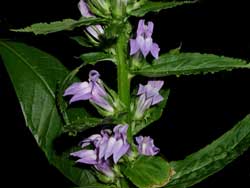Resource Library
Plant of the Week: Lobelia
The University of Arkansas System Division of Agriculture does not promote, support or recommend plants featured in "Plant of the Week." Please consult your local Extension office for plants suitable for your region.
Plant of the Week
Lobelia
Latin: Lobelia siphilitica

Medicine and botany were once closely linked disciplines with most of the cures prescribed by doctors derived from the natural world. Sometimes, these plant remedies worked, sometimes they didn't. The Great Blue Lobelia, Lobelia siphilitica, was one that didn't work to cure syphilis, but IT found a home in many gardens none the less.
The blue lobelia is a 2-foot tall perennial herb belonging to the bluebell family that is found in moist woodlands in the eastern half of North America. In Arkansas , it occurs in the Ozarks, in a few places in the Ouachitas and along Crawley's Ridge. The blue, tubular, five-parted flowers are produced at the top of the plant in a leafy spike in midsummer.
As explorers and traders moved about the world they collected the most valuable things first. Not surprisingly, corn, tobacco, potatoes, tomatoes, chili peppers, pineapples and pumpkins were the first plants collected and sent back to Europe.
Later waves of explorers sought medicinal plants to cure diseases. The use of quinine bark to fight malaria, shown to Jesuit priests in Lima, Peru in the 1630s by the native jungle tribes, was an early success story that set high expectations of effectiveness for native medicines.
But wresting information about aboriginal cures from native medicine men has always been a challenge. Not only were there obvious problems of translation and difficulty in accurate plant identification, but native shamans were often reluctant to share their secrets with outsiders.
An early traveler in Virginia in 1705 recounts how the "priests are also physicians" (medicine men) and reluctant to share the hidden qualities of plants with others lest they anger the gods. Ethnobotanists in the jungles of Brazil encountered the same reluctance in the 1960s when isolated tribes were first contacted by outsiders.
Syphilis is unique amongst the scourges of mankind in that it seems to be a New World disease that was transmitted to early European sailors after having sex with natives. For once the high degree of susceptibility was amongst the European population, not the Native Americans. The disease quickly spread throughout the world because the amorous nature of sailors is not a product of the modern age. Most native tribes had herbal remedies to combat its effects.
According to Peter Kalm, a student of Linnaeus and Sweetish professor who visited North America between 1748 and 1752, the blue lobelia was used by the Cherokees as a treatment for the disease. The plant had been in England since at least 1665, apparently grown in the flower border. But when Linnaeus handed out Latin names for plants described in his Species Plantarum that he completed in 1753, he chose to highlight the syphilis cure as the blue lobelia's defining feature.
But as a cure-all for the disease the blue lobelia was found wanting. Not to be outdone by the Swedes, William Johnson (the Crown's official agent assigned to keep peace with the native tribes) collected samples of the plant and sent it to doctors back in England for trial. It proved ineffective as a syphilis cure; but another lobelia species would emerge 75 years later as a principle ingredient for the patent medicine movement that swept the nation in the 19th century.
The blue lobelia can be grown in the shady, moist border throughout the state. If given a moist site and not allowed to be overgrown by neighboring plants, it will colonize the area. Individual plants are not long lived, especially if dry conditions insinuate themselves. It can be propagated by division or seed.
By: Gerald Klingaman, retired
Extension Horticulturist - Ornamentals
Extension News - July 14, 2006
The University of Arkansas System Division of Agriculture does not maintain lists of retail outlets where these plants can be purchased. Please check your local nursery or other retail outlets to ask about the availability of these plants for your growing area.